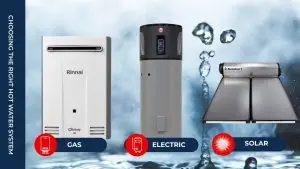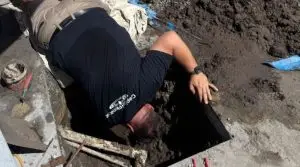If you’ve ever been jolted awake by an ice-cold shower on a winter’s morning, you’ll know just how crucial a reliable hot water system is. Unfortunately, most homeowners only think about their hot water unit after something goes wrong. But by doing a few simple checks throughout the year, you can avoid costly breakdowns, improve energy efficiency, and extend the life of your unit—whether it’s electric hot water or gas hot water.
This DIY hot water checklist has been put together by professional plumbers who’ve seen it all—leaks, rusted-out systems, safety issues, and poorly maintained heaters that failed long before their time. Whether you’re a homeowner or a property manager, this guide will help you stay ahead of the game and avoid cold showers.
Step-by-Step DIY Hot Water Checklist
1. Inspect the Unit for Leaks or Rust Marks
Every couple of months, do a quick visual inspection of your hot water system. Look for:
- Water pooling around the base
- Rust stains on the unit or on nearby walls or floors
- Bulging or swelling on the tank itself
Rust is an early warning sign that your tank may be corroding from the inside out. Even a small leak is cause for concern—it can quickly escalate into a burst tank or water damage. Slow leaks, if left unaddressed, can lead to significant water damage over time.
2. Clear the Area Around the Unit
Hot water systems—especially outdoor ones—should never be surrounded by mulch, leaves, or garden debris. Here’s why:
- Moisture buildup around the base encourages rust and corrosion.
- Termites and pests love to nest in debris and will sometimes find their way inside the unit or into your walls.
- Airflow is essential for combustion (in gas systems) and ventilation.
Keep at least a 30 cm clearance around the entire unit and ensure it’s sitting on a stable base, not soil.
3. Test the Temperature and Pressure Relief Valve (TPR Valve)
This is one of the most important safety checks you can do. The TPR valve prevents your hot water tank from building up dangerous levels of pressure. Here’s how to test it:
- Stand to the side of the unit to avoid hot water spray.
- Locate the valve at the top of the tank (it usually has a small lever).
- Gently lift the lever for 5 seconds—water should pour out of the overflow pipe.
- Release the lever and ensure the water stops flowing.
You should do this once every 3 months. If water doesn’t flow out or continues to drip afterwards, the valve may need replacing—call your plumber. Over-pressurisation can lead to dangerous situations if the temperature and pressure relief valve fails, making this check essential for safety.
Tips for Maintaining an Electric Hot Water System
Electric hot water systems are common in homes across Australia, especially in apartments and rural areas. They’re generally low-maintenance but still require care to operate efficiently and safely.
Flush the Tank Annually
Sediment from hard water can build up inside your tank, reducing efficiency and causing noisy operation. Once a year: Draining and flushing the tank helps remove sediment and minimizes tank corrosion, ensuring the system operates efficiently.
- Turn off the power supply at the switchboard.
- Attach a garden hose to the tank drain valve and run it to a safe drainage point.
- Open the valve and let the water run until it clears.
- Refill the tank and turn the power back on.
Note: If your system doesn’t have a drain valve or you’re unsure how to do this safely, call a licensed plumber.
Check the Element and Thermostat
Heating elements and thermostats can wear out over time, especially if your tank has a buildup of minerals. If you’re noticing: Faulty thermostats can result in inconsistent water temperatures in hot water systems, which is a common issue to watch for.
- Inconsistent water temperature
- Water that takes too long to heat
- Higher energy bills
…then it might be time to have the element inspected or replaced. These are jobs best left to a qualified electrician or plumber.
Replace the Sacrificial Anode
Most electric storage tanks have a magnesium or aluminum anode rod that attracts corrosion, protecting the tank walls. These should be replaced every 3–5 years, or sooner if you have hard water. Regular inspections of the anode rod can prevent tank corrosion and extend its lifespan significantly.
Tips for Maintaining a Gas Hot Water System
Gas hot water heaters are popular for their fast heating and lower running costs. However, they do need regular care, especially because they rely on proper ventilation and combustion.
Check the Pilot Light
If your water has suddenly gone cold, the pilot light may have gone out. First, read the manufacturer’s guide on relighting the pilot. If it won’t stay lit or keeps going out, it may indicate: Gas water heaters may fail to heat water if the pilot light goes out or the gas supply is disrupted, so these issues should be addressed promptly.
- A faulty thermocouple
- A blocked gas line
- A ventilation issue
Never attempt to repair gas lines yourself. If in doubt, contact a licensed gas fitter.
Inspect the Flue and Burner
Gas systems require proper ventilation to release combustion gases safely. Each year:
- Check the flue (the venting pipe) for obstructions like leaves or animal nests.
- Make sure there’s no rust, corrosion, or soot buildup.
- Inspect the burner flame—it should burn blue, not yellow. A yellow flame indicates incomplete combustion, which can be dangerous.
If anything seems off, shut the unit down and call a professional.
Listen for Unusual Noises
Rumbling, popping, or banging sounds can indicate sediment buildup in the bottom of the tank. Just like electric systems, gas tanks should be flushed once a year to remove debris. This improves heating efficiency and prolongs the unit’s life.
Bonus Tips for All Hot Water Units
- Insulate pipes: Especially if your unit is outdoors. This prevents heat loss and improves energy efficiency.
- Know the age of your unit: Most hot water systems have a lifespan of 8–12 years. If yours is older and giving you trouble, it might be more economical to replace it than keep repairing it. A water heater’s lifespan can last 10 to 12 years with routine maintenance.
- Schedule a professional service every 2 years: Even with regular DIY maintenance, it’s smart to have a licensed plumber give your system a thorough check every couple of years.
- Install a tempering valve: Required in most new homes, this prevents scalding by limiting the maximum water temperature delivered to taps.
When to Call a Professional
While this checklist covers simple DIY inspections and maintenance, there are times when only a licensed plumber or gas fitter should step in. Call in the pros if:
- The TPR valve keeps leaking after testing
- You notice rust or water stains
- Your water pressure suddenly drops
- There’s a gas smell around your unit
- The system is more than 10 years old and showing signs of wear
Final Thoughts
Preventing a cold shower is easier than you think. With just a few quick checks every couple of months, and a bit of maintenance once a year, you can keep your hot water flowing reliably—and avoid the drama and cost of emergency callouts.
Your hot water system works hard every day—give it a little TLC, and there will be no more cold showers.




